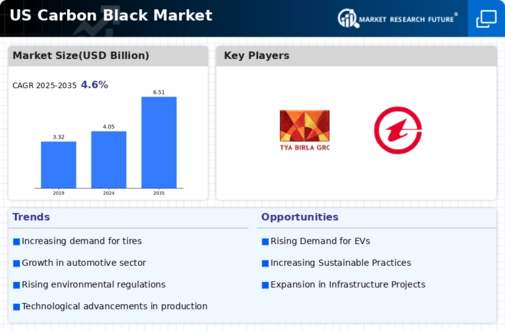Market Analysis
In-depth Analysis of US Carbon Black Market Industry Landscape
The US carbon black market is witnessing dynamic changes influenced by a combination of factors that impact both the supply and demand sides of the industry. Carbon black, a fine powder composed of elemental carbon, is a crucial industrial material used primarily as a reinforcing filler in rubber products and as a black pigment in inks and coatings. The market dynamics are shaped by factors such as technological advancements, the automotive industry's performance, environmental considerations, and the diverse applications of carbon black.
Technological advancements contribute significantly to the dynamic nature of the US carbon black market. Innovations in production processes, such as furnace black and channel black methods, have enhanced the quality and efficiency of carbon black manufacturing. Continuous research focuses on developing advanced grades of carbon black with specific characteristics to cater to the evolving needs of end-users. These technological improvements influence the cost-effectiveness and environmental sustainability of carbon black production, thereby impacting market dynamics.
The performance of the automotive industry is a key driver shaping the market dynamics of carbon black in the US. As a major consumer of carbon black, the automotive sector relies on this material for tire reinforcement, contributing to the overall safety and performance of vehicles. Fluctuations in automotive production, consumer demand for vehicles, and trends in tire manufacturing directly influence the demand for carbon black. Economic conditions and consumer preferences within the automotive industry play a pivotal role in shaping the consumption patterns of carbon black.
Environmental considerations are an important factor influencing the market dynamics of the US carbon black industry. The carbon black production process, particularly the traditional furnace black method, is associated with carbon dioxide emissions and environmental concerns. With a growing emphasis on sustainable practices and environmental regulations, there is increasing interest in cleaner and more sustainable methods of carbon black production. Technological advancements, such as the adoption of cleaner technologies and the development of more eco-friendly production processes, play a crucial role in addressing these environmental considerations and shaping the market dynamics.
The diverse applications of carbon black contribute to the dynamic landscape of the market. Apart from its predominant use in tire manufacturing, carbon black finds applications in a wide range of industries, including plastics, inks, coatings, and construction materials. The versatility of carbon black ensures that its market dynamics are influenced by trends in multiple sectors, making it a crucial industrial material with varied applications.
Competition within the market fosters innovation and efficiency in carbon black production. Companies are continually striving to differentiate themselves by offering high-quality carbon black products, exploring new applications, and optimizing production processes. Collaborations between carbon black manufacturers, tire producers, and research institutions contribute to ongoing research and development, driving innovation and influencing the competitive landscape of the carbon black market.
Socio-economic factors, including population growth, urbanization, and infrastructure development, contribute to the market dynamics of carbon black in the US. As urban areas expand, the demand for vehicles, tires, and construction materials increases, influencing the overall consumption patterns of carbon black. Economic trends and industrial activities directly impact the consumption of carbon black in various sectors, making it an essential component in the development and growth of infrastructure and manufacturing.





Leave a Comment